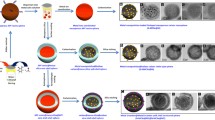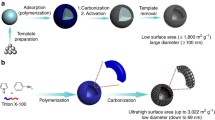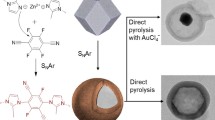Abstract
This study presents a new and simple method for the synthesis of hollow carbon spheres possessing nanocage sizes of 7.1, 14, and 20 nm in diameter. The core-shell (i.e., Cu@C) nanoparticles prepared by carbonization of the Cu2+–cyclodextrin (CD) complexes at 573 K for 2 h was etched with HCl (6N) to yield the hollow carbon spheres. The carbon-shell of the hollow carbon nanospheres, which consisted of mainly diamond-like and graphite carbons, is not perturbed during etching. In addition to the nanocages, the hollow carbon nanospheres also possess micropores with an opening of 0.45 nm, allowing small molecules to diffuse in and out through the carbon-shell. Many elements (such as Zn2+ or Cu2+) can therefore be filled into the nanocages of the hollow carbon nanospheres. With these unique properties, for instance, designable active species such as Cu and ZnO encapsulated in the carbon-shell can act as Cu–ZnO@C yolk-shell nanoreactors which are found very effective in the catalytic decomposition of methanol.








Similar content being viewed by others
References
Aragon SR, Pecora R (1976) Theory of dynamic light-scattering from polydisperse systems. J Chem Phys 64(6):2395–2404
Battie Y, Ducloux O, Thobois P, Dorval N, Lauret JS, Attal-Tretout B, Loiseau A (2011) Gas sensors based on thick films of semi-conducting single walled carbon nanotubes. Carbon 49(11):3544–3552
Beaucage G (1995) Approximations leading to a unified exponential power-law approach to small-angle scattering. J Appl Crystallogr 28:717–728
Beaucage G (1996) Small-angle scattering from polymeric mass fractals of arbitrary mass-fractal dimension. J Appl Crystallogr 29:134–146
Chen FL, Letortu A, Liao CY, Tsai CK, Huang HL, Sun IW, Wei YL, Paul Wang H (2010) Cu@C nanoparticles dispersed RTILs used in the DSSC electrolyte. Nucl Instrum Methods Phys Res A 619(1–3):112–114
Chiu YM, Huang CH, Chang FC, Kang HY, Wang HP (2011) Recovery of copper from a wastewater for preparation of Cu@C nanoparticles. Sustain Environ Res 21(4):279–282
Ciupină V, Zamfirescu S, Prodan G (2007) Evaluation of mean diameter values using Scherrer equation applied to electron diffraction images. In: Simeonova PP et al (eds) Nanotechnology—toxicological issues and environmental safety. Springer, New York, pp 231–237
Deshmukh AA, Mhlanga SD, Coville NJ (2010) Carbon spheres. Mat Sci Eng R 70(1–2):1–28
Eswaramoorthi I, Sundaramurthy V, Dalai AK (2006) Partial oxidation of methanol for hydrogen production over carbon nanotubes supported Cu–Zn catalysts. Appl Catal A 313(1):22–34
Feigin LA, Svergun DI (1987) Structure analysis by small-angle X-ray and neutron scattering. Plenum, New York and London
Feng XM, Mao CJ, Yang G, Hou WH, Zhu JJ (2006) Polyaniline/Au composite hollow spheres: synthesis, characterization, and application to the detection of dopamine. Langmuir 22(9):4384–4389
Guinier A, Fournet G (1955) Small-angle scattering of X-rays. Wiley, New York
Gulino A, LaDelfa S, Fragala I, Egdell RG (1996) Low-temperature stabilization of tetragonal zirconia by bismuth. Chem Mat 8(6):1287–1291
Han S, Yun Y, Park K-W, Sung Y-E, Hyeon T (2003) Simple solid-phase synthesis of hollow graphitic nanoparticles and their application to direct methanol fuel cell electrodes. Adv Mater 15(22):1922–1925
Hong C-I, Kang H-Y, Wang HP, Lin W-K, Jeng US, Su C-H (2011) Cu–ZnO@C nanoreactors studied by in situ synchrotron SAXS spectroscopy. J Electron Spectrosc Relat Phenom 184(3–6):301–303
Huang CH, Wang HP, Chang JE, Eyring EM (2009) Synthesis of nanosize-controllable copper and its alloys in carbon shells. Chem Commun 31:4663–4665
Kim M, Yoon SB, Sohn K, Kim JY, Shin CH, Hyeon T, Yu JS (2003) Synthesis and characterization of spherical carbon and polymer capsules with hollow macroporous core and mesoporous shell structures. Microporous Mesoporous Mat 63(1–3):1–9
Kment S, Hubicka Z, Kmentova H, Kluson P, Krysa J, Gregora I, Morozova M, Cada M, Petras D, Dytrych P, Slater M, Jastrabik L (2011) Photoelectrochemical properties of hierarchical nanocomposite structure: carbon nanofibers/TiO2/ZnO thin films. Catal Today 161(1):8–14
Li HB, Liang YY, Yin G, Wei XW, Xu Z (2008) Template-free fabrication of fullerene(C-60, C-70) nanometer-sized hollow spheres under solvothermal conditions. Carbon 46(13):1736–1740
Liu DG, Chang CH, Liu CY, Chang SH, Juang JM, Song YF, Yu KL, Liao KF, Hwang CS, Fung HS, Tseng PC, Huang CY, Huang LJ, Chung SC, Tang MT, Tsang KL, Huang YS, Kuan CK, Liu YC, Liang KS, Jeng US (2009) A dedicated small-angle X-ray scattering beamline with a superconducting wiggler source at the NSRRC. J Synchrot Radiat 16:97–104
Porod G (1980) Small angle X-ray scattering. Academic Press, New York
Saito N, Aoki K, Usui Y, Shimizu M, Hara K, Narita N, Ogihara N, Nakamura K, Ishigaki N, Kato H, Haniu H, Taruta S, Kim YA, Endo M (2011) Application of carbon fibers to biomaterials: a new era of nano-level control of carbon fibers after 30-years of development. Chem Soc Rev 40(7):3824–3834
Tongay S, Schumann T, Miao X, Appleton BR, Hebard AF (2011) Tuning Schottky diodes at the many-layer-graphene/semiconductor interface by doping. Carbon 49(6):2033–2038
Yagi I, Hayashi A, Kimijima K, Notsu H, Ohta N, Yamaguchi A (2010) Mesoporous materials toward nanofabricator and nanoreactor. Electrochemistry 78(2):105–113
Yoon SB, Sohn K, Kim JY, Shin CH, Yu JS, Hyeon T (2002) Fabrication of carbon capsules with hollow macroporous core/mesoporous shell structures. Adv Mater 14(1):19–21
Zhou GJ, Lu MK, Yang ZS (2006) Aqueous synthesis of copper nanocubes and bimetallic copper/palladium core-shell nanostructures. Langmuir 22(13):5900–5903
Zhou JS, Song HH, Chen XH, Zhi LJ, Yang SY, Huo JP, Yang WT (2009) Carbon-encapsulated metal oxide hollow nanoparticles and metal oxide hollow nanoparticles: a general synthesis strategy and its application to lithium-ion batteries. Chem Mater 21(13):2935–2940
Acknowledgments
The financial supports of the Taiwan National Science Council and Bureau of Energy are gratefully acknowledged.
Author information
Authors and Affiliations
Corresponding author
Rights and permissions
About this article
Cite this article
Tsai, CK., Kang, H.Y., Hong, CI. et al. Preparation of hollow spherical carbon nanocages. J Nanopart Res 14, 1315 (2012). https://doi.org/10.1007/s11051-012-1315-5
Received:
Accepted:
Published:
DOI: https://doi.org/10.1007/s11051-012-1315-5




